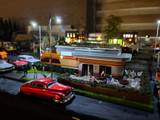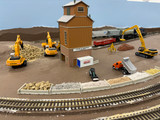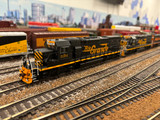Adding Realism to Your Model Railroad: Incorporating Structures and Buildings
Model railroading is a captivating hobby that allows enthusiasts to create and immerse themselves in miniature worlds. One of the most rewarding aspects of this hobby is adding structures and buildings to your layout. These architectural elements not only enhance the overall aesthetics of your model railroad but also bring a sense of realism and narrative to the scene. In this article, we will explore the art of incorporating structures and landmarks into your layout, as well as the techniques of weathering and detailing buildings for a heightened sense of authenticity.
Incorporating Structures and Landmarks into Your Layout
A well-designed model railroad layout is more than just tracks and trains; it's a microcosm of the real world. Structures and landmarks play a crucial role in creating a believable environment that transports viewers to another time and place. Here are some tips to consider when incorporating buildings into your layout:
- Scale and Proportion: Choose buildings that are appropriate for the scale of your model railroad. Whether you're working with HO scale, N scale, or another size, make sure the structures complement the overall scene. Pay attention to proportions, ensuring that the buildings don't overwhelm the trains or the landscape.
- Context and Storytelling: Think about the context and purpose of each building. Is it a rural farmhouse, a bustling city skyscraper, or a quaint village cottage? Every structure tells a story, so consider the era, location, and theme of your layout. This will help you create a cohesive narrative that resonates with viewers.
- Placement and Integration: Carefully place buildings to create a natural flow within your layout. Avoid arranging structures in a straight line, as this can appear unrealistic. Instead, create clusters or groupings that mimic the organic arrangement of buildings in real life. Integrate structures with the surrounding landscape by adding realistic terrain features like roads, pathways, and greenery.
- Customization and Kitbashing: While ready-to-use building kits are convenient, customizing and kitbashing structures can add a unique touch to your layout. Combine elements from different kits or scratch-build certain details to create a one-of-a-kind building. This allows you to exercise your creativity and tailor structures to fit your specific vision.
Weathering and Detailing Buildings for Realism
To truly capture the essence of the real world, your model railroad structures should exhibit signs of age, wear, and weathering. Weathering and detailing are essential techniques that add depth and authenticity to your buildings. Here's how you can achieve this level of realism:
- Painting and Aging: Start by painting your structures using colors that mimic real building materials. Use weathering powders, washes, and techniques like dry brushing to simulate wear and tear. Pay attention to areas that would naturally experience more exposure, such as corners, edges, and rooftops.
- Texture and Materials: Experiment with various materials to replicate different textures. Incorporate wood, plastic, paper, and other materials to achieve the desired look. For instance, simulate rust on metal surfaces, create chipped paint on wooden walls, and add realistic brickwork using appropriate techniques and materials.
- Details and Accents: Small details make a big difference. Add elements like window shades, signage, awnings, and gutters to enhance the authenticity of your structures. Consider the era and location of your layout to accurately depict architectural styles and design elements.
- Fading and Foliage: Buildings are not isolated from their environment. Over time, natural elements can take a toll on structures. Use airbrushing or painting techniques to create sun-faded areas on walls and rooftops. Incorporate realistic foliage, such as vines or moss, to convey a sense of age and abandonment.
- Interior Lighting: For an added layer of realism, consider installing interior lighting in your structures. Illuminating windows can give the illusion of inhabited spaces, further enhancing the storytelling aspect of your layout.
In conclusion, adding structures and buildings to your model railroad layout is an art that requires attention to detail, creativity, and a deep understanding of architectural design. By carefully incorporating structures and landmarks that align with your layout's theme and era, as well as applying weathering and detailing techniques, you can elevate your model railroad to a new level of realism. Each building becomes a piece of history frozen in time, inviting viewers to step into a captivating world of miniature wonders.
Recent Posts
-
Enhancing Your Model Railroad: Adding Spectacular Special Effects
Embarking on the journey of model railroading opens up a world of creativity and craftsmanship, wher
-
All Aboard the Wisdom Express: Life Lessons from Model Railroading
Embarking on the journey of model railroading opens the door to a world where imagination meets prec
-
Capturing History in Miniature: The Art of Prototype Modeling in the Model Railroad World
Prototype modeling in the model railroad world involves creating miniature replicas of real-life tra




